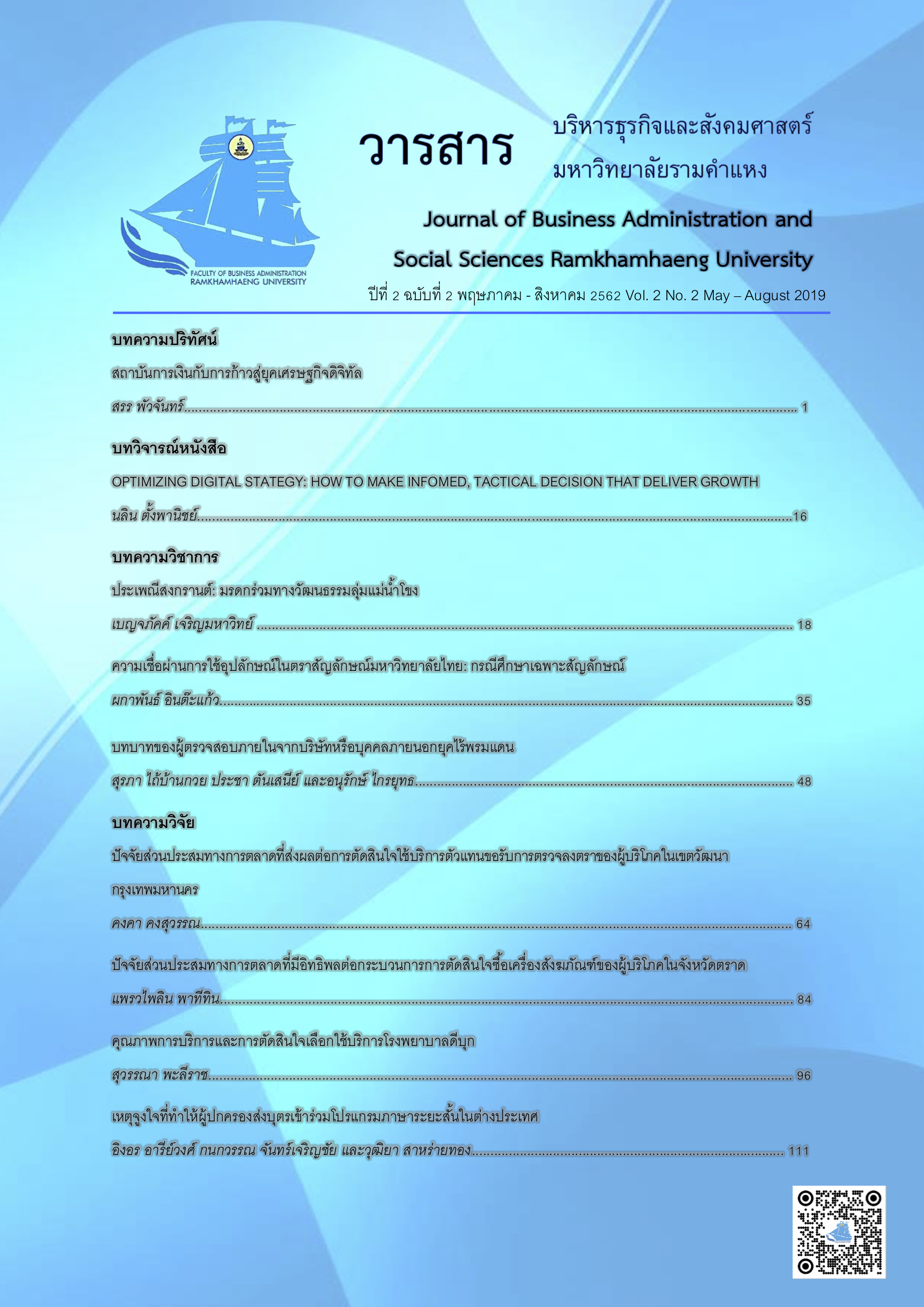FINANCIAL INSTITUTION AND STEPPING INTO THE ERA OF DIGITAL ECONOMY
Main Article Content
Abstract
Currently, businesses bring in modern technology to support planning and decision making. Financial institutions use new technology in a variety of forms, resulting in a change in service provision to customers. An important factor that affects the success of technology implementation is the development of new skills for personnel, such as the ability to perform data processing and big data analysis and to comprehend in-depth information. Due to the fact that financial institution businesses in the digital economy era often involve a great deal of customer information, it is absolutely necessary for financial institutions to conduct data analysis from existing information in order to search for customer insights and then apply them into business operations. Meanwhile, another great challenge in stepping into the digital economy is the ability to identify the identity of the customers in the digital world, so that financial institutions could reach and deliver basic financial services to their customers. Hence, stepping into the digital economy era, financial institutions are confronted with challenges from themselves, existing competitors, related law and regulations and potential newcomers that might cause business disruption to the existing business model.
Article Details
เนื้อหาและข้อมูลในบทความที่ลงตีพิมพ์ในวารสารบริหารธุรกิจและสังคมศาสตร์ มหาวิทยาลัยรามคำแหง ถือเป็นข้อคิดเห็นและความรับผิดชอบของผู้เขียนบทความโดยตรง ซึ่งกองบรรณาธิการไม่จำเป็นต้องเห็นด้วย หรือร่วมรับผิดชอบใดๆ
บทความ ข้อมูล เนื้อหา รูปภาพ ฯลฯ ที่ได้รับการตีพิมพ์ในวารสารบริหารธุรกิจและสังคมศาสตร์ มหาวิทยาลัยรามคำแหง ถือเป็นลิขสิทธิ์ของวารสารบริหารธุรกิจและสังคมศาสตร์ มหาวิทยาลัยรามคำแหง หากบุคคลหรือหน่วยงานใดต้องการนำบทความทั้งหมดหรือส่วนหนึ่งส่วนใดไปเผยแพร่ต่อ หรือเพื่อกระทำการใดๆ จะต้องได้รับอนุญาตเป็นลายลักษณ์อักษรจากวารสารบริหารธุรกิจและสังคมศาสตร์ มหาวิทยาลัยรามคำแหง ก่อนเท่านั้น
References
Brynjolfsson, E., & Kahin, B. (2002). Understanding the Digital Economy: Data, Tools, and Research. Cambridge, MA: MIT Press.
Carlsson, B. (2004). The digital economy: What is new and what is not? Structural Change and Economic Dynamics, 15(3), 245-264.
Chiu, I. H-Y. (2016). FinTech and disruptive business models in financial products, intermediation and market: Policy implications for financial regulators. Journal of Technology, Law, and Policy, 21, 55-112.
Dermine, J. (2017). Digital disruption and bank lending. European Economy: Banks, Regulation, and the Real Sector, 2, 63-76.
Durand, A. (2017). Customer Identities Are the Common Denomination in Changing Business Model. Retrieved March 18, 2019, from https//www./pingidentity.com/en/company/blog/posts/2017/customer-identities-are-the-commondenominator-in-changing-business-models.html
Gabor, D., & Brooks, S. (2017). The digital revolution in financial inclusion: International development in fintech era. New Political Economy, 22(4), 423-436.
Gasperini, F. (2018). Are You Shaping Your Bank’s Digital Future or Is It Shaping You?. Retrieved July 12, 2019, from https://www.ey.com/gl/en/industries/financial-services/fso-insights-are-you-shaping-your-banks-digital-future-or-is-it-shaping-you.
Gomber, P., Kauffman, R. J., Parker, C., & Weber, B. W. (2018). On the fintech revolution: Interpreting the forces of innovation, disruption, and transformation in financial services. Journal of Management Information Systems, 35(1), 220-265.
Haltiwanger, J., & Jarmin, R. S. (1999). Measuring the Digital Economy. Retrieved July 12, 2019, from https://pdfs.semanticscholar.org/95fc/71c62cd6f6fc8132e8d5823f7633ce25ca0c.pdf?ga=2.112716547.668655833.1566205168122541315.1561044666.
KPMG. (2018). Emerging Risks and Evolving Responses: Exploring the Challenges Facing Banking and How the Industry can Respond. Retrieved July 25, 2019, from https://home.kpmg/content/dam/kpmg/uk/pdf/2019/02/emerging-risks-and-evolving-responses.pdf
Li, S. (2003). Future trends and challenges of financial risk management in the digital economy. Managerial Finance, 29(5/6), 111-125.
Navaretti, G. B., Calzolari, G., & Pozzolo, A. F. (2017). FinTech and banks: Friends or foes. European Economy: Banks, Regulation, and the Real Sector, 2, 9-30.
Nikolova, I. (2018). What Are the 5 Key Components of IAM in the Digital Transformation Process?. Retrieved August 2, 2019, from https//www.patecco.com/en/blog/ what-are- the-5-key-components-of-iam-in-the-digital-transformation-process.
Sangroya, A., Kumar, S., Dhok, J., & Varma, V. (2010). Towards analyzing data security risks in cloud computing environments. Communications in Computer and Information Science, 54, 255-265.
Scheibach, M. (2019). 2019 Banking Trends: Facing the Challenges and Seizing the Opportunities. Retrieved July 28, 2019, from https://www.fintechamericas.com/
news/2019-banking-trends-facing-the-challenges-and-seizing-the-opportunities/.
Tapscott, D. (1998). Blueprint to the Digital Economy: Creating Wealth in the Era of E-Business. New York: McGraw-Hill.
Vives, X. (2017). The impact of fintech on banking. European Economy: Banks, Regulation, and the Real Sector, 2, 97-105.
Vovchenko, N. G., Andreeva, A. V., Orobinskiy, A. S., & Filippov, Y. M. (2017). Competitive advantages of financial transactions on the basis of the blockchain technology in digital economy. European Research Studies Journal, 20(3B),193-212.
World Bank. (2017). 1.1 Billion ‘Invisible’ People Without ID Are Priority for New High-Level Advisory Council on Identification for Development. Retrieved June 28, 2019, from http://www.worldbank.org/en/news/press-release/2017/10/12/11-billion-invisible-people-without-id-are-priority-for-new-high-level-advisory-council-on-identification-for-development.
World Economic Forum. (2015). The Future of Financial Services: How Disruptive Innovations are Reshaping the Way Financial Services are Structured, Provisioned and Consumed. Retrieved June 20, 2019, from http://globaltrends.thedialogue.org/publication/the-future-of-financial-services-how-disruptive-innovations-are-reshaping-the-way-financial-services-are-structured-provisioned-and-consumed/.
Zimmermann, H. D. (2000). Understanding the digital economy: Challenges for new business models. Paper presented at Association for Information Systems Conference on Understanding the Digital Economy: Challengers for New Business Models. SSRN Electronic Journal, DOI: 10.2139/ssrn.2566095.


